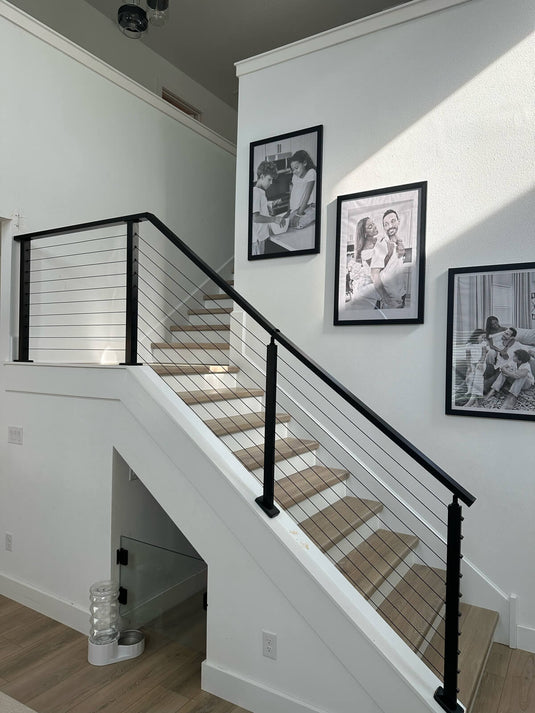TABLE OF CONTENTS
Cable Railing for Decks: Cost, Features and More

Looking to give your deck a facelift that combines both style and sturdiness? Cable railings might just be the answer. These sleek lines offer a clear view of your surroundings while keeping things safe and up-to-code. They're a bit more of an investment upfront than traditional wood, but they'll save you time and money on upkeep in the long run. The cost varies—thicker cables and tougher materials like marine-grade stainless steel may bump up the price, but they're worth it for that rust-free longevity. Factor in labor, design details, and the size of your deck, and you’re looking at a range of prices. But don't let numbers scare you off—their modern look, durability, and low maintenance make cable railings a smart pick for your outdoor space.
Cost of Cable Railings
Installing cable railings on your deck can have upfront costs higher than more traditional wood railings, but lower maintenance expenses in the long run. The total cost depends on several factors:
Materials
●Cables: The price can vary depending on the thickness of the cables and the type of metal used. Marine-grade stainless steel is the preferred choice due to its resistance to rust and corrosion, especially in harsh climates or coastal areas. Prices for stainless steel cables can range from $0.75 to $1.50 per foot.
●Posts and Hardware: The material of the posts and hardware greatly affects cost. Stainless steel, aluminum, and galvanized steel are common options. For example, stainless steel end posts can cost between $50 and $150 each, while tensioner kits can run from $10 to $30 per set. Turnbuckles and other tensioning hardware also add to this cost, potentially contributing several hundred dollars to a full project.
Labor
Installation charges for cable railings can be high due to the precision required. Labor costs vary by region but expect to pay anywhere from $50 to over $100 per hour for skilled labor. A typical railing project may require 10 to 20 hours of labor, depending on complexity, which translates to $500 to $2,000 in labor costs alone.
Design Complexity
Simple, straight runs are less expensive than designs requiring custom angles or curves. Furthermore, additional features such as integrated lighting or custom finishes on the handrail or posts will increase the overall cost.
Height and Length
●The total height of your deck off the ground doesn't necessarily change the cost of the materials per linear foot, but it can affect the number of cables needed for proper safety compliance. Generally, code requires less space between cables for higher decks, meaning more rows of cabling.
●The perimeter length of your deck will directly influence how much material you need. More linear footage means more cables, posts, and hardware, increasing the material cost proportionally.
Additional Factors
●Local building codes can impact the cost if they require specific types or grades of materials.
●Accessibility of the installation site and the need for any special equipment to safely install the railings on higher or uniquely designed decks can also add to the cost.
Overall Cost Estimate
Considering these details, a ballpark figure for a professionally installed cable railing system ranges widely:
●Standard materials with straightforward installation might start at around $60 per linear foot.
●Mid-range projects with higher-quality materials and more complex designs can go for $90 to $120 per linear foot.
●High-end systems featuring the best materials, custom design work, and additional features like lighting can exceed $200 per linear foot.
These cost estimates suggest that a typical 20-foot straight run could range from $1,200 to $4,000 or more, factoring in both materials and labor at varying levels of complexity and quality.

Features and Benefits of Cable Railing for Decks
Cable railings come with a range of features and benefits that make them a popular choice for open deck designs:
●Aesthetics: The thin, transparent cables provide unobstructed views of the surroundings, creating a contemporary, sleek look. This fits with modern and minimalist home designs. The simple posts don't detract from views the way bulky wood railings can.
●Durability: Cable railings hold up well to moisture, sun exposure, and other elements because quality cables use marine-grade stainless steel. The cable materials are rot, rust, and corrosion-resistant. Properly installed posts offer stability.
●Low Maintenance: Homeowners save on upkeep costs compared to wood railings that require periodic staining, sealing, and splinter repairs. Cable railings just need occasional checks of cable tension.
●Safety: Properly spaced and tensioned horizontal cables meet International Residential Building Code standards for guardrails. This prevents falling accidents, especially important on higher decks.
●Customization: Homeowners can select the number of cables, the spacing between them, post style, and color for design flexibility. More customization means higher project costs.
Cable railings are not only a visually appealing addition to any deck but also offer practical advantages in terms of durability, safety, and maintenance. They provide a clean, modern look without obstructing views, stand up against the elements with minimal care required, and can be tailored to fit the unique style of any home.

Additional Considerations
While cable railings offer beauty and versatility, they also come with additional installation and maintenance considerations:
●Snow and Wind Load Capacity: Cable railings perform well against wind uplift, but large snow loads in certain climates may require tighter cable spacing or stronger posts. Consult local codes.
●Decking Compatibility: The posts mount to the surface below the cables, so cable systems work with any decking type. Most integrate fine with wood or composites. Special post flanges are made for concrete or stone surfaces.
●Professional Installation: Proper cable tensioning provides safety while allowing the system to feel taut but bounce back when pressed. This precision is challenging for DIY projects, so installation is best left to experienced deck builders.
●Permits: Building departments enforce code compliance. Many require permits specifically for cable railings given safety implications. Permits also apply for second-story decks. Plan your project timeline and budget accordingly.
●Maintenance: While cable railings are low maintenance, they still require occasional upkeep. Tension should be checked yearly, with tightening or adjusting as needed. Lubricate all hardware pieces to prevent squeaking.
In climates with heavy snow or rainfall, be vigilant about allowing water to pool at posts to prevent ice dams or rust over time.
Cable Railings Await - Are You Ready for a Change?
Cable railings offer a stellar combination of aesthetic appeal, durability, and ease of maintenance that make them a top contender for any deck design. By seamlessly merging with the environment, they provide an uninterrupted view that traditional options can't match, all while adhering to safety standards crucial for elevated outdoor spaces.
When considering cable railings, remember to factor in the various components that contribute to the overall cost—materials, labor, design complexity, height, length, and additional factors like local building codes. Although the upfront investment may be steeper than some alternatives, the trade-off is a sophisticated look coupled with a resilience that stands the test of time.




